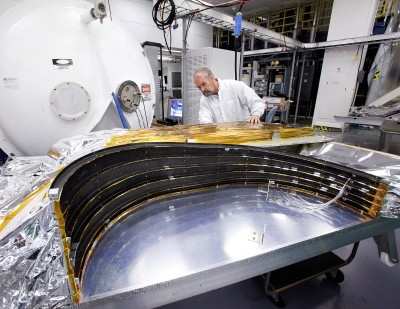Verifies Flight Design For Space Observatory
NASA's James Webb Space Telescope continues to make significant
progress, successfully completing a series of sunshield vent tests
that validate the telescope's sunshield design.

Webb Telescope Sunshield NASA Image
"While adequate venting is a design consideration for all
spaceflight hardware, this was a particularly unique challenge for
the sunshield given the large volume of trapped air in the membrane
system at launch," said Keith Parrish, Webb telescope sunshield
manager at NASA's Goddard Space Flight Center in Greenbelt, MD.
"From the beginning of its development venting features have been a
critical part of the overall sunshield design. Since we
cannot vent test the actual flight article these tests have shown
the design works and the sunshield will vent safely on its way to
orbit."
The sunshield on the Webb telescope will block the heat of the
Sun and Earth from reaching the cold section of the Observatory.
That's a critical function because the telescope and instruments
must be cooled below 50 Kelvin (-369.7 Fahrenheit) to allow them to
see faint infrared emissions from astronomical objects. The
sunshield consists of five layers of Kapton E with aluminum and
doped-silicon coatings to reflect the sun's heat back into
space.

Webb Telescope Sunshield NASA Image
Using flight-like sunshield membranes, the tests are designed to
mimic the rapid change in air pressure the folded sunshield will
experience the first minutes of launch. Several different folding
configurations each underwent a series of 90-second
depressurization tests and proved that the stowed sunshield will
retain its shape during launch and allow trapped air to escape
safely, both critical to sunshield deployment and performance.
Northrop Grumman Corporation is leading Webb's design and
development effort for NASA's Goddard Space Flight Center in
Greenbelt, Md. The first tests were conducted the last week of
August in vacuum chambers at Northrop Grumman Aerospace Systems'
Redondo Beach facility. Another series of complementary tests were
completed in October where air was injected into the stowed
sunshield test article, and that provided more detailed data used
in evaluating analytical models.
"This is another significant risk reduction activity that
continues to move sunshield development forward," said Scott
Willoughby, Webb Telescope program manager for Northrop Grumman
Aerospace Systems. "We have demonstrated the effectiveness of our
sunshield vent design."
Three critical full-scale sections of the sunshield were tested:
the section on top of the spacecraft around the tower that supports
the telescope; the vertical pallet structure that contains the
folded sunshield membranes, and the intervening four-bar linkage
area that is folded in an inverted V-shape. The flow paths are
complex and the sunshield material, a tough plastic film, Kapton E,
is only one to two thousandths of an inch thick and covers a
surface area the size of a tennis court.

Webb Telescope Artist's Concept NASA Image
The James Webb Space Telescope is the world's next-generation
space observatory and successor to the Hubble Space Telescope. The
most powerful space telescope ever built, Webb will observe the
most distant objects in the universe, provide images of the very
first galaxies ever formed and see unexplored planets around
distant stars.
 ANN's Daily Aero-Linx (04.16.24)
ANN's Daily Aero-Linx (04.16.24) Aero-News: Quote of the Day (04.16.24)
Aero-News: Quote of the Day (04.16.24) Airborne 04.10.24: SnF24!, A50 Heritage Reveal, HeliCycle!, Montaer MC-01
Airborne 04.10.24: SnF24!, A50 Heritage Reveal, HeliCycle!, Montaer MC-01 Airborne 04.12.24: SnF24!, G100UL Is Here, Holy Micro, Plane Tags
Airborne 04.12.24: SnF24!, G100UL Is Here, Holy Micro, Plane Tags Airborne-Flight Training 04.17.24: Feds Need Controllers, Spirit Delay, Redbird
Airborne-Flight Training 04.17.24: Feds Need Controllers, Spirit Delay, Redbird





